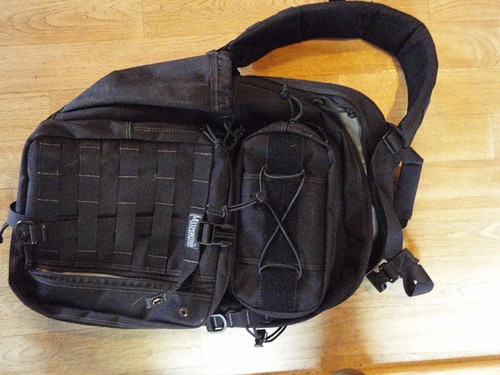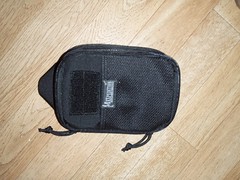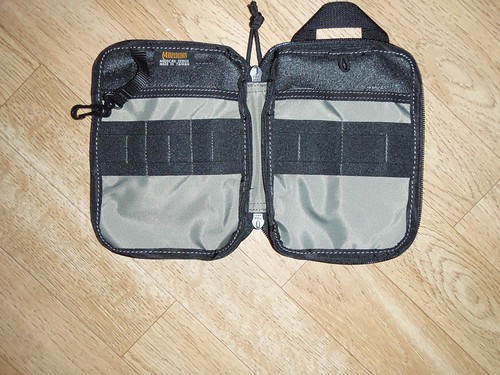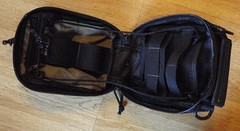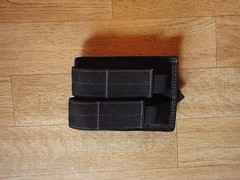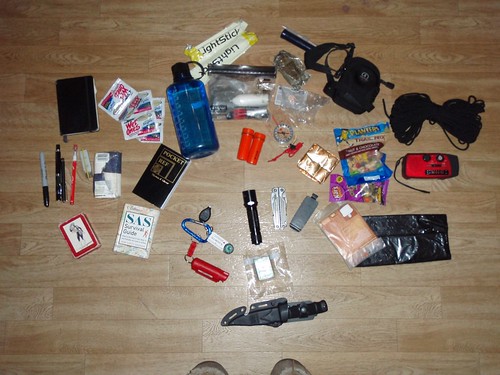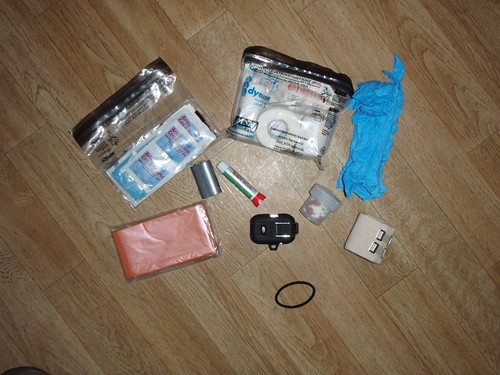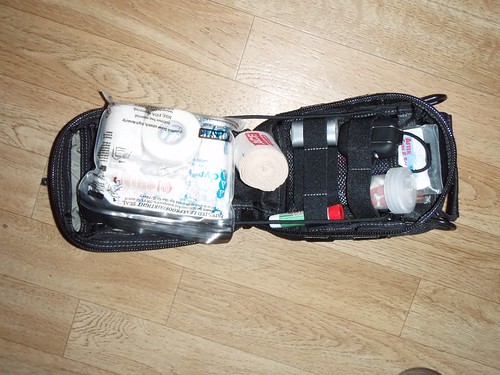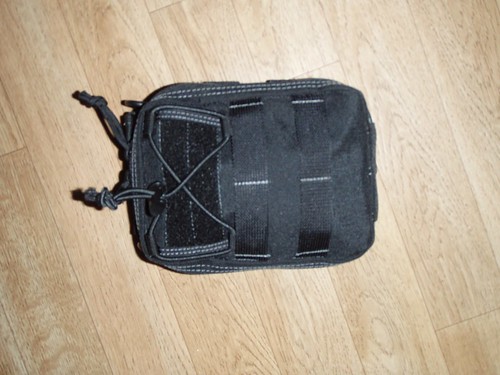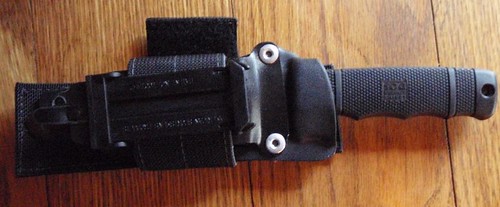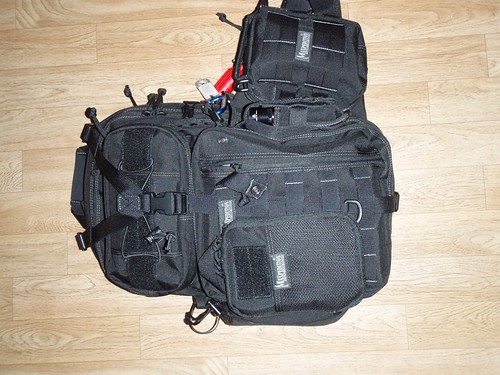What is it?
Whether we think about it or not, we all have some level of what in some circles is called EDC, or EveryDay Carry. This is a term often applied amongst gun enthusiasts to their chosen self-defense weapon, but has been expanded to include those items you make sure you always have on you or very nearby. It is the latter we will be talking about in this post.
Why do it?
The simple fact is there are certain things we need on us in our daily life and many more that would come in handy. Women have been masters of this for years. Think back on all the things your mother could pull out of a purse or handbag at a moments notice! Men, of course, have long resisted the desire to follow suit as it just isn't "macho" enough, but many of us have been carrying backpacks long past our school years. Laptops have become a great excuse to carry more with us without looking like we have a "man-purse", but a recent surge in messenger and sling bags, many with a tactical slant, have made it more acceptable to carry more stuff with us.
While we so often expect to be able to hit a convenience store when we need something, life doesn't always work that way. To be clear, I'm not talking about a "72-hour" or a "Bug Out Bag", which tend to be larger survival style bags. I plan to tackle that at some point, but here I'm speaking of something far more universal and versatile. A few simple things carried in a comfortable bag can make all the difference between a good or bad day!
How did I learn it?
At this point, do I even need to mention Boy Scouts? Seriously, "Be Prepared" sticks in your head! But I honed this over the last 20 years, first in college, then in the working world. My time as an EMT had an immense impact in this area as I learned you want to have everything you are likely to need when you get to a patient, but you can only carry so much, especially into, say, a wrecked vehicle. When I moved into IT and a laptop became something I toted around all the time, I shifted things again. Finally, learning to ride a motorcycle has led me to rely less on what might be in my vehicle (otherwise a large pickup), causing me to have a refined list of things that I never want to be without.
How do you learn it?
I'm going to give you my opinions here, then you should absolutely read what other people say. Mostly, however, you should try it out yourself. Some of this you'll discount immediately, some of it you'll take as gospel, but a lot will be experimentation. Try it out, don't spend a lot upfront, and see what works for you. But put some thought into it, otherwise you end up with more than you bargained for, like so many mothers have done!
The bag - For many of the women out there, you already have a favorite EDC or 2 in the form of a purse. Many, like my wife, don't carry a purse in the traditional sense but a small shoulder bag instead. Some of us favor backpacks or laptop roller bags. I've carried a variety of things over the years, including a waist bag (essentially a big fanny pack). Whatever you settle on is less vital than a few key criteria.
Is it comfortable for you? You're the one who will end up carrying it all the time, so your opinion is the most important. If you will be carrying a lot of weight, like a laptop, this is even more critical.
Is it maneuverable? This is why I moved away from a roller bag for my laptop. I found it was terrible on rough terrain and even slowed me down in the airport. The extra weight of a backpack was worth it.
Does it have space for what you'll be carrying? It seems obvious, but buying a bag then realizing there isn't a pouch that will handle your ever-present hardback book will certainly disappoint. When possible I like to take my largest item to the bag to verify, but when ordering online pay close attention to the dimensions. On the same note, too big will be bulky and lead you not to carry it, or carry too much!
Is it durable? This may not be a big issue for some, but I hate falling in love with a bag then having it fall apart or look terrible after a few months of work. Many fabrics such as canvas, nylon, Codura, and leather hold up well to continued abuse
Can you get to your stuff? Organization is often overlooked. I've passed it over many times myself, and I've watched others have to empty out a bag to find a single thing they wanted. Think about it up front, but realize you can organize in big compartments with smaller pouches and bags.
My current bag is the predecessor of
this one, but after about 6 years of constant use it is wearing thin, so will be replaced this week by the
Maxpedition Kodiak. I realized I almost never use both straps for the backpack and wanted better organization options, so we'll see how the Kodiak serves.
First aid - One thing I'm big on is having some first aid supplies on hand, no matter who you are or how much you actually know. Band-aids, some gauze and tape, tweezers, and alcohol wipes are a bare minimum. I also find it handy to have a bit of my vital medicine on me at all times, along with some painkillers. If you don't know what to put in a kit or like getting it all together, light and affordable(ish), check out
Adventure Medical. They're industry leaders and have a variety of products you can pick up online or at your local EMS or Cabelas. Even if you don't know what to do with the items in the kit, someone around you might, but without the items available their knowledge may be for not. And, of course, take a first aid course! :)
Fire and light - Less people smoke these days (which is a good thing!) but it means few folks have a lighter or matches on them. This is a small, easy item to have on you that comes in handy whether you get stuck in the woods, need to scorch the end of a nylon strap, or sanitize a needle to dig out a splinter. I carry both, and also a magnesium fire-starter, but I'm all about the backup.
Similarly, you never know when you'll need a flashlight. I carry 2 myself, a small keychain-style LED light and a palm-sized tactical (very bright) one. They're great when you lose something under your desk, need to check out an issue with your car, or find yourself in a dark parking lot. I also have a few
glow sticks to act as quick area lighting/flares.
Tools and knives - I've talked about pocket knives
before, and your EDC is a good place to carry something to back that up. A multi-tool that may be more than you want in your pocket is perfect here and serves a lot of purposes. I also carry a fixed-blade knife in my EDC, but that may be more than most want.
On top of those, I have a few other more survival based items. One of the most used is a cheap poncho. I keep replacing it as it comes out in those moments when I forget a rain coat. A compass is handy, but this is only good if you know how to use one, and best with a map. I also have a small, straw-style
water filter which I have yet to use and hope never to do so.
Writing items - This may seem obvious, but having a pen when you - or someone else - needs it is a huge boon. I'd also remind you to carry something to write on besides gas receipts. I have a small Moleskine-style notebook I got at Barnes & Noble with tear-out pages. I've recently gotten back into the habit of carrying a Sharpie as well, a habit from my EMT days. I'm less likely to be writing on people with it now, but it still works on almost any surface you come across.
Defense - We hope never to need it, but it would suck to need it and not have it. I'll skip the whole topic of firearms for another post as it's such a polarizing topic, but I will encourage everyone (even if you do carry a gun) to have some form of defensive spray as a non-lethal option. I won't go into the choosing of pepper spray here, but send you instead to this
great site about it. The idea of a self-defense item is not to permanently disable someone, it is to give you time to get to safety. Whether you do that with pepper spray, a taser, a defensive tool like a
kubotan, a tactical flashlight, or whatever, just having a way to gain a few seconds to run to your car or a safe building can make a huge difference to you and those who hope you make it home safe. Give it some thought.
Random stuff - There are a few other things I like to carry with me that may not be important to others, but I find useful.
Trash bags - I have about 4 of these at any time, the large, black ones. They make impromptu ponchos, ways to carry wet or dirty clothes, and, of course, work for trash. They could be used for a shelter if you were hard up, but that's an extreme.
Paracord - The mainstay of survivalists everywhere, this thin, light cord works for so many situations. It holds knots well, doesn't stretch easily, and is fairly cheap. Use it to lash something onto the roof of the car, hold something onto your pack, or any number of situations where rope comes in handy. A 50' bundle is small and easy to carry.
Books - I almost always have one with me. Actually, I DO always have my pocket version of the
SAS Survival Handbook with me, but I also normally have what I'm reading or my iPad so I can keep myself entertained during long waits. Of course, the Survival Guide has other uses than general reading.
Cards - Nothing cures boredom quicker than a game, in my experience, so a deck of cards is handy when stuck at a slow restaurant or waiting for AAA to come give you a tow. I currently only have a standard deck, but sometimes I carry other quick, small games like
Fluxx
What else can you tell me that may not be common knowledge?
I've laid out a mess of stuff here, and I'm hoping others chime in with their experiences. It is worth noting that one bag will not likely serve all of your needs. I've changed what I carry over the years and bags have changed with me. When traveling you may need to pair down to meet space or TSA requirements. This is actually part of what led me to my new EDC bag, specifically the integration of the
MOLLE system.
While designed for the military and obviously appealing to the "tacti-cool" crowd, I see a lot of appeal to those of us who travel a lot or need to change up what we carry. As pouches can easily be swapped on or off the webbing, it becomes possible to mix and match to create the perfect bag. Better still, in minutes you can take the pouches with your multi-tool or pepper spray off the bag and tuck them in your checked baggage before heading off through airport security. I'll be putting this bag through its paces in the near future and I'll let you know how the system works out for me.
The single most important thing to remember is that YOU have to carry this day in and out, so build the system that works best for you and don't be afraid to change it when it doesn't.
